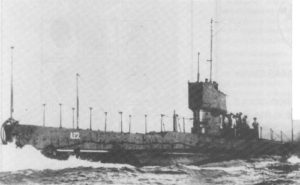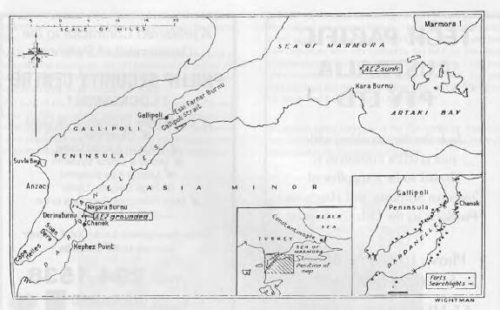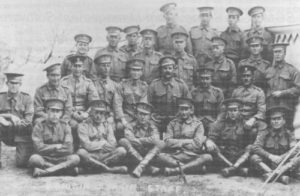- Author
- Swinden, Greg
- Subjects
- WWI operations
- Tags
-
- RAN Ships
- HMAS AE2
- Publication
- March 1996 edition of the Naval Historical Review (all rights reserved)

Mention Gallipoli to any Australian and they will immediately think of bronzed ANZACs storming ashore at ANZAC Cove on 25th April 1915, Simpson and his donkey evacuating wounded, or the heavy fighting at the Battles of Lone Pine or the Nek. Few, if any think of the RAN’s small but significant role in this campaign.
The RAN had two units involved in the Gallipoli campaign. These were the submarine AE2 and the Royal Australian Naval Bridging Train (RANBT). Both served with distinction and ironically the AE2 was the first Australian unit to go into action at Gallipoli and the RANBT the last Australian unit to leave the Peninsula.

On 24 April the Australian submarine AE2 under Lieutenant Commander H.H.G.D. Stoker RN was ordered to penetrate the Dardanelles, a narrow heavily mined strip of water separating the Gallipoli peninsula from the rest of Turkey. Stoker’s orders were to create havoc behind the Turkish lines whilst the ANZACs were landing, and “to run amok generally”. Although AE2’s officers and senior sailors were on loan from the Royal Navy the majority of her crew were Australian born.
At 0230 on the 25th AE2 began her approach to the Dardanelles and after several tense hours Submarine AE2 including being fired at by Turkish shore batteries and snagging the mooring wires of several mines the AE2 made it through to the sea of Marmara, thus becoming the first Allied submarine to breach Turkish defences.
AE2 began to run amok generally and fire her torpedoes at a variety of targets. At one point a Turkish battleship was bombarding ANZAC positions when AE2’s periscope was sighted approaching the ship. The Turkish ship ceased firing and ran for safety just at the time its shelling was becoming most effective. Meanwhile ashore on the peninsula things were not going to plan. The Turkish defence was particularly strong, the Australians had suffered heavy casualties and many troops were lost or disorganised. Serious consideration was being given to evacuating the ANZACs.

The British Commander General Hamilton was considering the potential evacuation when news of AE2’s penetration of the Dardanelles was received. Hamilton immediately discarded all thought of evacuation and immediately sent the following signal to the troops ashore: “Your news is indeed serious, but dig yourself in and stick it out. It would take at least two days to re-embark you. Meanwhile the Australian submarine has got through the Narrows and torpedoed a Gunboat at Chanak. Make an appeal to your men to make the supreme effort to hold their ground. You have got through the difficult business. Now all you have to do is dig, dig, dig until you are safe.”
What could have been a short three day raid became an eight month campaign and cost over 8000 Australian lives. If not for AE2’s actions it is highly likely that the ANZACs would have been evacuated and the legend of Gallipoli would have been stillborn.
AE2 continued her attacks on Turkish ships but on 30 April was attacked and sunk by the Turkish torpedo boat Sultan Hissar. Her crew of 32 survived the sinking, however, all were taken prisoner. During the next three years of captivity four men from AE2 died from disease and ill treatment.
Although the RAN’s presence at Gallipoli had ended with the loss of AE2, it was not to be long before it was back in a role that was just as unlikely and just as unexpected.

The Royal Australian Naval Bridging Train was formed in Melbourne in February 1915 under the command of Lieutenant Commander Leighton Seymour Bracegirdle (later Rear Admiral Bracegirdle).
The Bridging Train consisted mainly of Naval Reservists who could not be employed in RAN warships. They wore Light Horse uniforms but with anchor badges replacing the Army rising sun badges and Naval badges of rank. The Bridging Train was organised as a horse drawn engineering unit and it was originally planned they would serve on the Western Front in France with the British Army. Like their ANZAC cousins they were diverted to the Mediterranean theatre of war.




